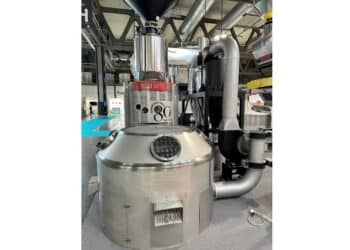When it comes to instant coffee manufacturing, Stefan Schenker, Head of Busin undefined
ess Unit Coffee for Buhler, explains that today’s companies have two main options.
For years, instant coffee manufacturing has sat in the hands of a select group of major multinationals who could invest in research and development needed for “traditional” instant coffee manufacturing. What mainly sets traditional manufacturing apart are the aroma recovery phases that sit on either end of the extraction phase, to ensure that instant coffee replicates the brew of a fresh cup.
“There are very sophisticated methods to recover the aroma,” explains Schenker. “Most major companies continue to use this technology today.”
Although most companies will keep the specifics of this phase a secret, Schenker explains that during the grinding and de-gassing phase it can generally involve nitrogen gas flushing to collect the aroma compounds.
A second aroma recovery phase occurs after extraction, generally known as stripping, to extract the aromas out of the liquid using steam. These aromas are then put back into the coffee prior to drying.
In addition to concentrating on this aroma recovery, major companies are also quite interested in maximising extraction yields. Currently, leading instant coffee manufacturers produce a final product mass that represents up to 60 per cent of the roasted bean. Compared to the around 22 per cent extraction yield a person would get brewing at home, these high yield levels via traditional processing methods translate into helping companies maximise their profits.
It’s in maximising yield levels that Buhler can lend its expertise to traditional instant coffee manufacturing. Schenker explains how the roasting process can play an important role in helping companies push their manufacturing to the next level.
“The extraction yield depends on many different factors. One factor is of course the sophistication of the extraction technology itself. But it also depends on the microstructure of the roasted bean,” says Schenker. “There are lots of pores that water has to go through to access the soluble material in the solid matrix. With a very porous structure, the water can better percolate the matrix and better transfer solubles into the liquid phase, and thus increase the extraction yield. With the roasting process, we can influence the pore structure of the bean.”
Last year, Buhler introduced its new InfinityRoast technology that allows the user to produce non-traditional roast profiles. The technology allows precise control over the time/temperature curve and the air-to-bean ratio, parameters that can be used to influence the bean’s structure.
Schenker explains that, for example, a slow start with a fast final roast, using a low air-to-bean-ratio, helps maximise the porosity of the beans. The result is a higher extraction yield.
“The InfinityRoast can do this profile with very precise process control,” says Schenker. “Thanks to our control system, we can reproduce this profile to a high degree of accuracy, batch by batch.”

“Now you can have instant coffee that can actually produce a crema,” he says. “It’s something we’ve never seen before in instant coffee.”
All of this technology has helped advance the “traditional” method of producing instant coffee. And while it continues to be practiced strongly today, Schenker explains how some years back major roast and ground companies popularised an “alternative” way of producing instant coffee, shaking up the stronghold of these multinationals.
“These companies did not have the technology for sophisticated aroma recovery,” explains Schenker. “So they came up with the idea of using ultrafine ground coffee in the final product.”
Some of the traditional roast and ground companies were able to bypass the aroma recovery phases by adding real, finely ground coffee to instant coffee.
This new alternative method has found a welcome audience in the instant coffee segment. Schenker says it’s created an impressive opportunity for companies without the research and development capacities to invest in sophisticated aroma recovery, but nevertheless get into the instant coffee space with a decent product quality.
The investment, however, in this alternative method of producing instant coffee, falls on the grinding side. Schenker explains how traditional instant coffee manufacturers typically use a very coarse grind, as they need to ensure that the grinds don’t block the filters.
“If there are too many fines blocking the filters, it can really affect the operational efficiency of the extraction process,” he explains. “You want to ensure your equipment can run continually for as long as possible before cleaning is required.”
For this level of grinding, Buhler offers its one or two-pass version of the GrindDefine technology, a grinder that can achieve homogenous course grinding. Alternative instant coffee manufacturing requires a different grinder set-up, when the coffee needs to be very finely ground to be introduced into the final product. Fortunately, Buhler can also lend its expertise in this space.
“This is really pushing the limits of roller grinding technology. This has to be very fine coffee,” he says. “Grinding is actually one of Buhler’s core competencies. We have a lot of experience, thanks to our work in chocolate and grains.”
Buhler’s three-pass roller grinder allows the creation of some of the finest particle sizes on the market.
“We’re taking the technology as far as it can go,” he says. “When a customer is drinking instant coffee, and 10 per cent of it is roast and ground, they don’t even notice unless they read the packaging. They will notice the taste.”






